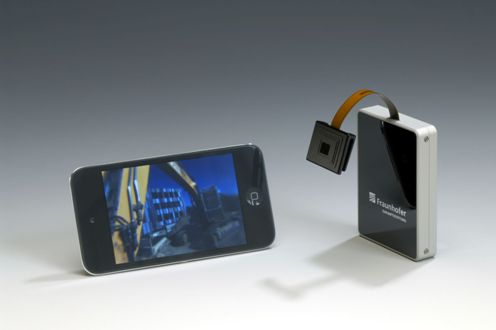A flat camera 2mm thick – technology ideal for integration into smartphones, as well as in medical and industrial equipment – has been developed by Fraunhofer researchers. The mini-camera concept called FacetVision will be shown at the CES technical trade fair in Las Vegas from 5-8 January.

The first prototype of the technology transfers the images from the camera to the smartphone by Bluetooth via a transmission box. Credit: Fraunhofer IOF
The thin camera contains a mosaic lens array composed of 135 tiny facets that operates similar to an insect eye. Each facet receives only a small section of its surroundings and, because of the offset of each lens to its associated aperture, each optical channel has an individual viewing direction and always depicts another area of the field of vision.
‘With a camera thickness of only 2mm, this technology, taken from nature’s model, will enable us to achieve a resolution of up to four megapixels,’ said Andreas Brückner, project manager at the Fraunhofer Institute for Applied Optics and Precision Engineering IOF in Jena, Germany. ‘This is clearly a higher resolution compared to cameras in industrial applications – for example in robot technology or automobile production.’
The technology was developed together with scientists from the Fraunhofer Institute for Integrated Circuits IIS in Erlangen and was funded by the Fraunhofer-Zukunftsstiftung.
The Fraunhofer scientists say the micro-lenses can be manufactured in large quantities using processes similar to those applied in the semiconductor industry.
The cameras are suitable for use in medical engineering, for instance as optical sensors to examine blood. Other applications include cameras in cars to aid parking, integration into industrial robots, or use in the next generation of smartphones.
Smartphone cameras typically have a lens 5mm thick, which is often too thick for the phone housing. In addition, these lenses are not made on wafers, but in injection moulded plastic.
‘We would like to transfer the insect eye principle to this [phone camera] production technology,’ says Brückner. ‘For example, it will be possible to place several smaller lenses next to each other in the smartphone camera. The combination of facet effect and proven injection moulded lenses will enable resolutions of more than 10 megapixels in a camera requiring just a thickness of around 3.5mm.’

